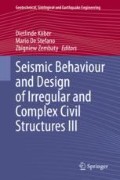Abstract
Pounding between neighboring structures during seismic events has been revealed as one of the most commonly observed reasons for severe damage or even total collapse of the adjacent buildings. Therefore, pounding effects have recently become an issue of great interest of many numerical and experimental investigations in many earthquake-prone regions of the world. It has also been observed that the differences in dynamic characteristics is the key reason leading to interaction between colliding, insufficiently separated structures. The problem is much more complicated for complex arrangements of structures, for example, in the case of collisions between few structures in a row. A lot of different approaches have been considered to mitigate earthquake-induced structural pounding. One method is based on placing between the structures some viscoelastic elements acting as bumpers. Another one is stiff linking the structures. It allows the forces to be transmitted between buildings and thus eliminate undesired interactions. The aim of this paper is to present the results of experimental research focused on mitigation of pounding between buildings in complex arrangements by using polymer elements installed between structures. In the present study, three steel models characterized by various dynamic properties and different in-between distances were investigated. Additional masses were mounted at the top of each model in order to obtain different dynamic characteristics. The unidirectional shaking table, available at the Gdansk University of Technology (Poland), was employed to conduct this study. Experimental models were mounted to shaking table platform. The results of the study explicitly show that the approach of using polymer elements can be an effective pounding mitigation technique in the case of complex arrangement of buildings. It may partially or fully prevent from damaging collisions between adjacent buildings during seismic events. It also enhances the dynamic response leading to the reduction in lateral vibrations under different strong ground excitations.
Access this chapter
Tax calculation will be finalised at checkout
Purchases are for personal use only
References
Anagnostopoulos SA (1988) Pounding of buildings in series during earthquakes. Earthq Eng Struct Dyn 16:443–456
Anagnostopoulos SA, Spiliopoulos KV (1992) An investigation of earthquake induced pounding between adjacent buildings. Earthq Eng Struct Dyn 21:289–302
Bertero VV, Collins RG (1973) Investigation of the failures of the Olive view stairtowers during the San Fernando earthquake and their implications on seismic design. EERC report no 73-26, University of California, Berkeley, USA
Elwardany H, Seleemah A, Jankowski R (2017) Seismic pounding behavior of multi-story buildings in series considering the effect of infill panels. Eng Struct 144:139–150
Falborski T, Jankowski R (2017) Experimental study on effectiveness of a prototype seismic isolation system made of polymeric bearings. Appl Sci 7(8):808. https://doi.org/10.3390/app8030400
Falborski T, Jankowski R (2018) Advanced hysteretic model of a prototype seismic isolation system made of polymeric bearings. Appl Sci 8(3):400. https://doi.org/10.3390/app8030400
Favvata MJ, Karayannis CG, Liolios AA (2009) Influence of exterior joint effect on the inter-story pounding interaction of structures. J Struct Eng Mech 33:113–136
Jankowski R (2005) Impact force spectrum for damage assessment of earthquake-induced structural pounding. Key Eng Mater 293–294:711–718
Jankowski R (2015) Pounding between superstructure segments in multi-supported elevated bridge with three-span continuous deck under 3D non-uniform earthquake excitation. J Earthq Tsunami 9(4), paper no 1550012
Jankowski R, Mahmoud S (2015) Earthquake-induced structural pounding. Springer, Basel
Jankowski R, Mahmoud S (2016) Linking of adjacent three-storey buildings for mitigation of structural pounding during earthquakes. Bull Earthq Eng 14:3075–3097
Karayannis CG, Favvata MJ (2005) Earthquake-induced interaction between adjacent reinforced concrete structures with non-equal heights. Earthq Eng Struct Dyn 34:1–20
Kasai K, Maison B (1997) Building pounding damage during the 1989 Loma Prieta earthquake. Eng Struct 19:195–207
Maison BF, Kasai K (1990) Analysis for type of structural pounding. J Struct Eng 116:957–977
Maison B, Kasai K (1992) Dynamics of pounding when two buildings collide. Earthq Eng Struct Dyn 21:771–786
Naderpour H, Barros RC, Khatami SM, Jankowski R (2016) Numerical study on pounding between two adjacent buildings under earthquake excitation. Shock and vibration 2016, article ID 1504783
Polycarpou PC, Papaloizou L, Komodromos P (2014) An efficient methodology for simulating earthquake-induced 3D pounding of buildings. Earthq Eng Struct Dyn 43:985–1003
Rosenblueth E, Meli R (1986) The 1985 earthquake: causes and effects in Mexico City. Concr Int 8:23–34
Sołtysik B, Jankowski R (2013) Non-linear strain rate analysis of earthquake-induced pounding between steel buildings. Int J Earth Sci Eng 6:429–433
Sołtysik B, Jankowski R (2016a) Earthquake-induced pounding between asymmetric steel buildings. In: Zembaty Z, De Stefano M (eds) Geotechnical, geological and earthquake engineering 40: seismic behaviour and design of irregular and complex civil structures II. Springer, Cham, pp 255–262
Sołtysik B, Jankowski R (2016b) Influence of separation gap on the response of colliding models of steel structures under seismic and paraseismic excitations. In: Kleiber M, Burczyński T, Wilde K, Górski J, Winkelmann K, Smakosz Ł (eds) Advances in mechanics: theoretical, computational and interdisciplinary. CRC Press/Balkema, London, pp 533–536
Vasiliadis L, Elenas A (2002) Performance of school buildings during the Athens earthquake of September 7 1999. 12th European conference on earthquake engineering, paper no 264
Author information
Authors and Affiliations
Corresponding author
Editor information
Editors and Affiliations
Rights and permissions
Copyright information
© 2020 Springer Nature Switzerland AG
About this chapter
Cite this chapter
Sołtysik, B., Falborski, T., Jankowski, R. (2020). Study on Polymer Elements for Mitigation of Earthquake-Induced Pounding Between Buildings in Complex Arrangements. In: Köber, D., De Stefano, M., Zembaty, Z. (eds) Seismic Behaviour and Design of Irregular and Complex Civil Structures III. Geotechnical, Geological and Earthquake Engineering, vol 48. Springer, Cham. https://doi.org/10.1007/978-3-030-33532-8_30
Download citation
DOI: https://doi.org/10.1007/978-3-030-33532-8_30
Published:
Publisher Name: Springer, Cham
Print ISBN: 978-3-030-33531-1
Online ISBN: 978-3-030-33532-8
eBook Packages: Earth and Environmental ScienceEarth and Environmental Science (R0)

